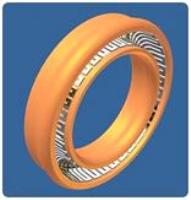Omniseal Solutions’s OmniSeal® 400A spring-energized seal has been qualified as a dynamic seal in rotary union applications for the marine industry. Common for this industry, many rotary unions are used in marine turret applications on off-shore vessels but are also utilized in chemical, semiconductor/robotics and oil & gas industries.
 OmniSeal 400A Spring-Energized Seal
OmniSeal 400A Spring-Energized Seal
A rotary union (also referred to as a rotary joint) consists of a metallic rotating housing and a stationary shaft assembled together with seals and bearings. At times, the housing can be stationary while the shaft rotates. As a result of the relative rotation between the shaft and the housing, such assembly allows for transfer of fluid from the stationary component into and/or out of the rotating component.
Rotary unions have proven to be very beneficial and versatile because they are engineered to endure a large range of temperature and pressure for a variety of conditions and environments, may integrate multiple independent flow connections (passages) and are able to handle different types of media simultaneously. When deciding on using a rotary union, one must consider such factors as media, pressure, temperature and speed and when the transfer requirement is very precise and periodic.
The heart of the rotary union is the seal as it prevents the medium from leaking outside the rotary union while in operation. The extended heel of the OmniSeal® 400A seal, which consists of a jacket made out of PTFE-based Fluoroloy® material and a cantilevered spring, provides the desired level of contact and sealing force in a low rotary speed application. The jacket and the spring combination help to seal water- based hydraulic fluid in the hardware. An additional back-up ring made from a high modulus polymer material helps to contain operating pressure of around 5,000 psi. In such applications, the 400A seals rotating shaft sizes range from a few inches to a few feet in diameter, with temperature range from -40°F to 120°F and very low rotary speed.
Aside from the 400A design, OmniSeal® spring-energized seals are available in multiple designs such as 103A, SR II, APS, RP II, RACO 1100A and are also offered in various custom designs. These designs include seal jackets in various Fluoroloy® materials and springs in various configurations. The Seals Group’s sealing solutions have been used in a variety of applications such as the Atlas V rocket engine (which launched the Mars Rover Curiosity into space), the only full-powered, reusable, battery-operated endoscopic stapler in the world and the world’s first subsea gas compression station.
Please contact the Omniseal Solutions at [email protected] for assistance with unique applications or visit their website, www.seals.saint-gobain.com for more information on spring-energized seals.